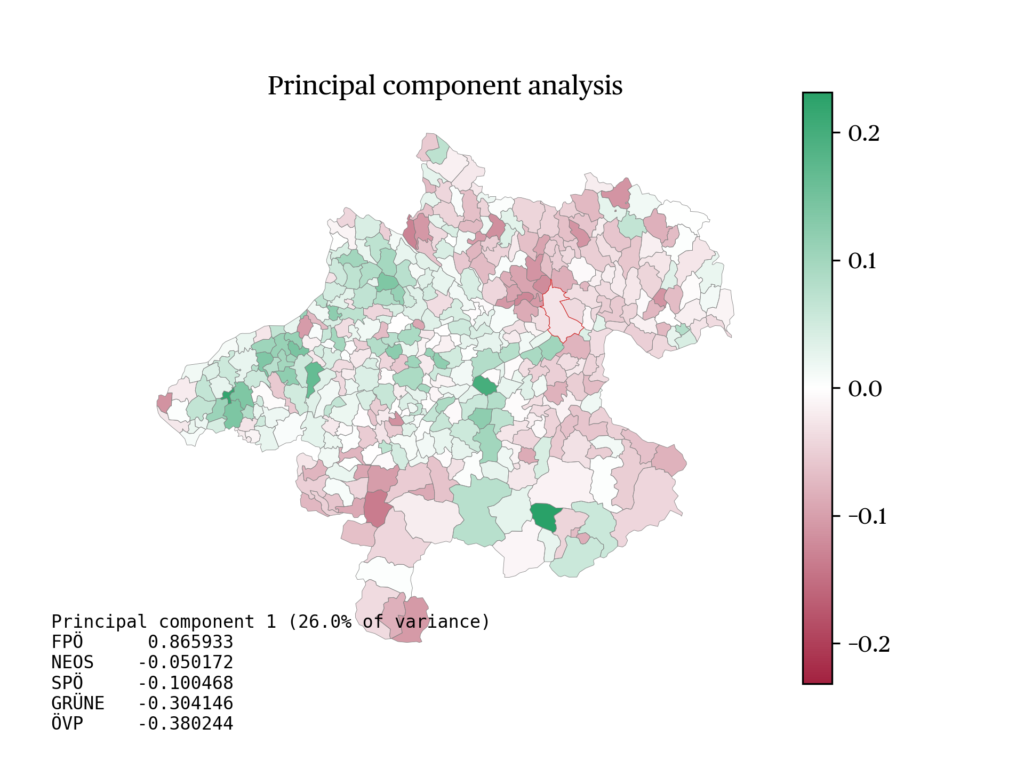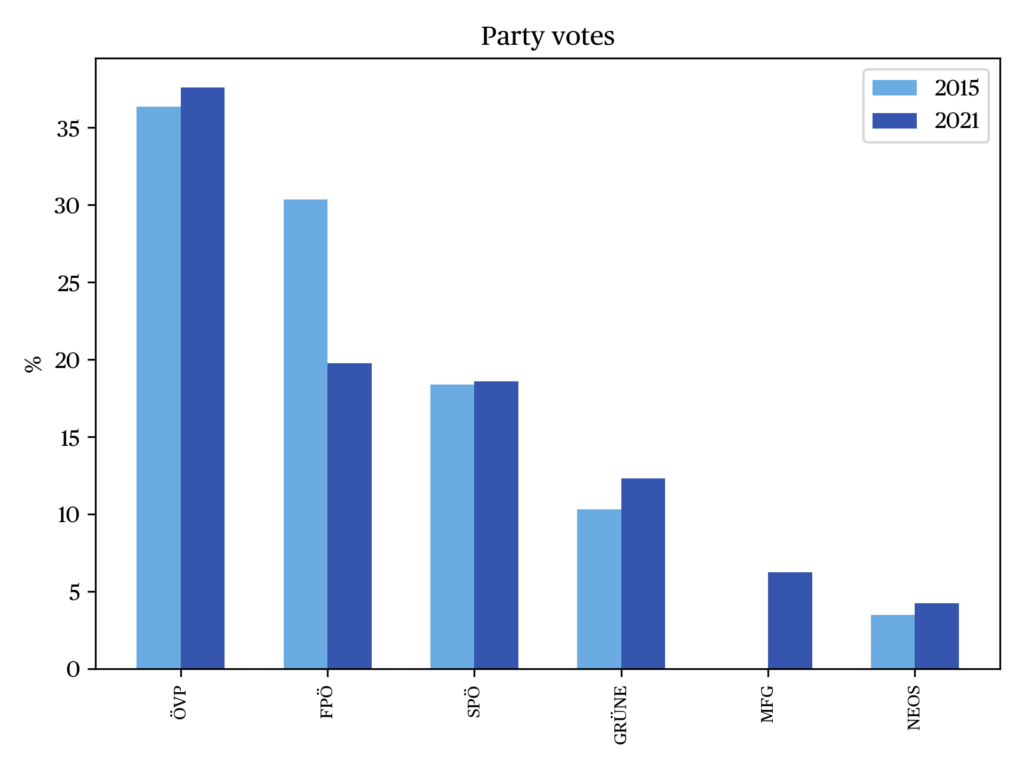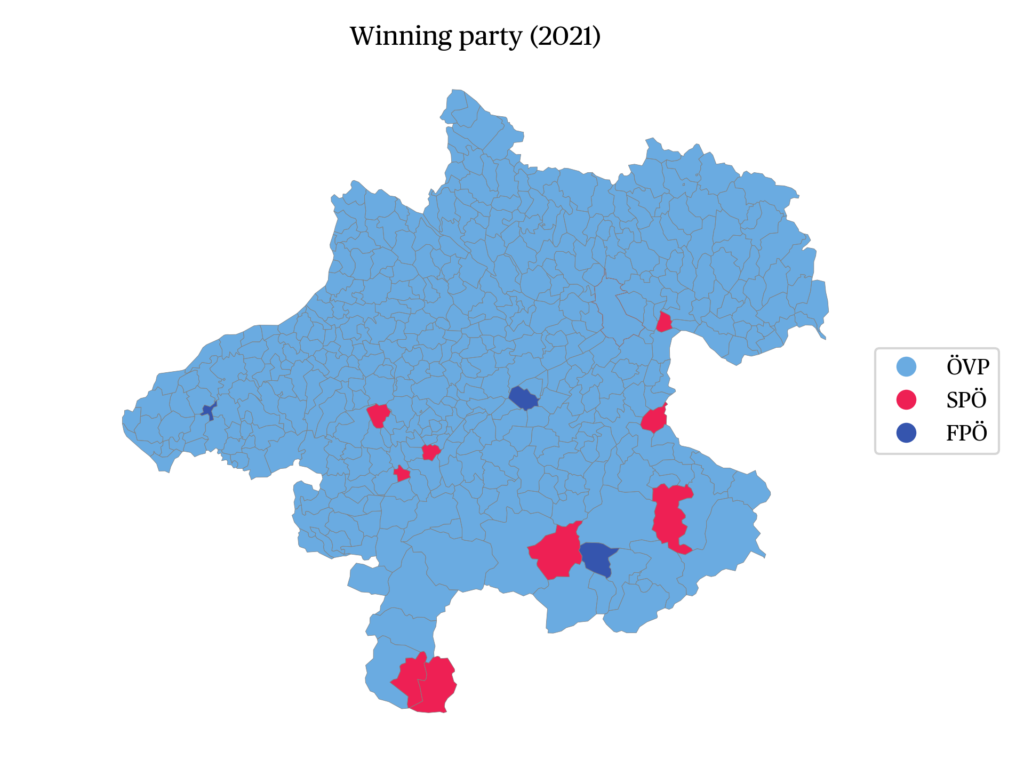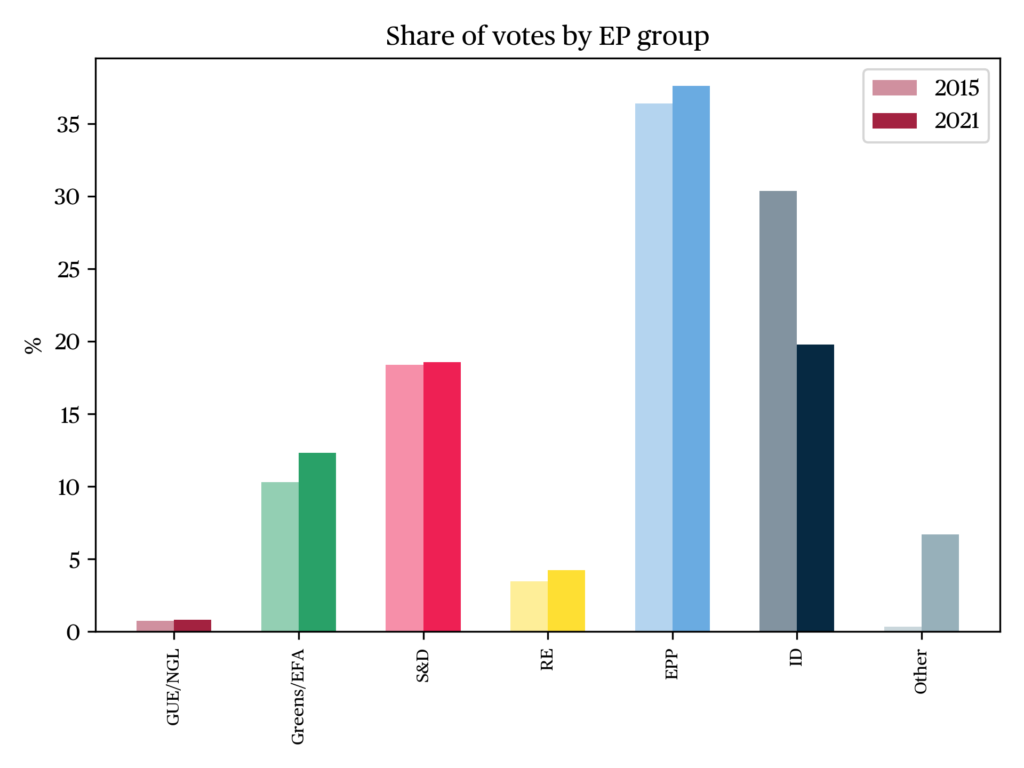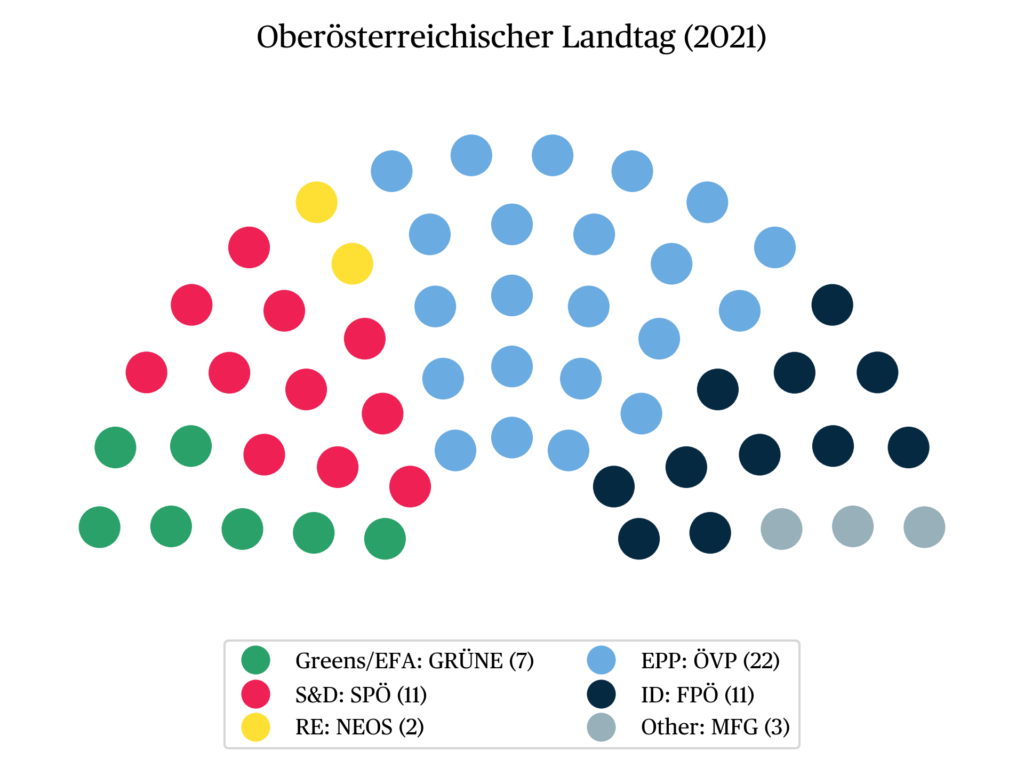Regional election in Upper Austria, 26 September 2021
Harald Stöger
Senior Lecturer at Johannes-Kepler-Universität LinzIssue
Issue #2Auteurs
Harald Stöger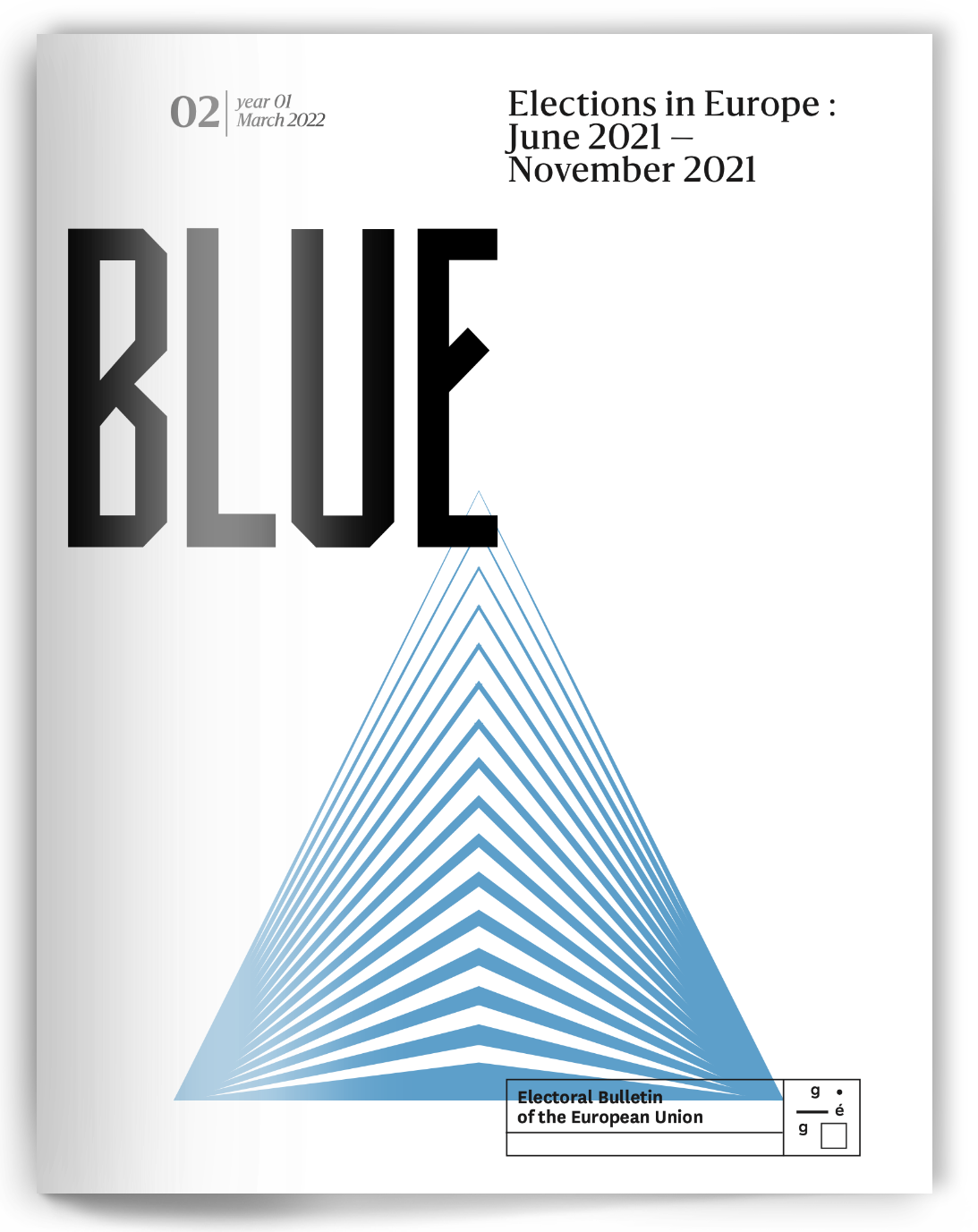
21x29,7cm - 167 pages Issue 2, March 2021 24,00€
Elections in Europe : June 2021 – November 2021
The context of the state election
The last two state elections in Upper Austria in 2015 and 2021 took place under very different contextual conditions. While the 2015 Landtag election happened during the large refugee movement, the Covid-19 pandemic marked the 2021 election, which impacted the election campaign. Parties’ and their candidates traditional (“analogue”) campaign events could only be held with significant restrictions and with limited attendance. The pandemic, especially the question of how to deal with non-vaccinated people, led to a certain polarisation in the Upper Austrian society, as according to a survey 22% of citizens show no interest in Covid vaccination (ORF 2021). Especially younger, less formally educated people as well as women reject vaccination for various reasons. At the time of the state election, Upper Austria was at the bottom of the list among the Austrian regions with a vaccination rate of 59% of the total (vaccine-eligible) population.
1
Federal political trends also played a certain role. In Vienna, a federal government consisting of the Austrian People’s Party (ÖVP) and the Greens under Federal Chancellor Sebastian Kurz (ÖVP) had taken office at the beginning of 2020. After initial support, the federal government’s measures to combat Covid-19 met with increasingly fierce criticism from the parliamentary opposition formed by the Social Democratic Party (SPÖ), the Freedom Party of Austria (FPÖ) and the New Austria Party (NEOS). Moreover, as the pandemic went on, the acceptance of these measures declined steadily in the Austrian population (Research Affairs 2021). Around two weeks before the state election, the federal government decided on gradual tightening measures in view of rising Covid-19 infections, and ten days before the election, the Federal Minister of Health (Greens) imposed temporary exit controls for the Upper Austrian district of Braunau, justified by high local incidences. It could not be clearly predicted how these restrictive measures by the federal government would affect voting behaviour in Upper Austria. Voters could express their displeasure with the new restrictions imposed by the federal government or, on the contrary, their acceptance of them in the elections.
The Upper Austrian electoral and governmental system marks another important parameter for the Landtag election (Dachs 2006 : 1012 sqq.). In principle, proportional representation applies, with a 4% clause
2
that favours larger parties and makes it more difficult for small parties to enter the parliament. There is no direct election of the regional governor (Landeshauptmann), who is elected by the state parliament with an absolute majority for a six-year term. Upper Austria is one of the last Bundesländer in Austria to have a proportional representation government, in which the larger parties are represented according to their share of the vote in the elections.
3
Within this proportional representation government with four parties, two parties form a coalition and agree on a government programme for the six-year legislative period.
Since 1945, Upper Austria has been dominated by the Austrian People’s Party (ÖVP), which has also appointed the governor without interruption. The long-time Governor, Dr. Josef Pühringer, had handed over his office to Thomas Stelzer during the recent legislative period in order to enable his successor to build up a trust bonus. Governor Stelzer, who has been in office since April 2017, was able to inspire confidence in his work through his calm and objective demeanour. Satisfaction with the work of the regional government (79 %, January 2021) and with the activities of Governor Stelzer (80 %, January 2021) was at a relatively high level. According to a Spectra survey of July 2021, 73 % of the Upper Austrians surveyed had a ‘good opinion’ of the governor.(Nachrichten 2021). Thus, Stelzer would have won a fictitious direct election of the state governor with a respectable lead of up to 37 % points over the runner-up.
The ÖVP dominates the regional parliament and government, thus overshadowing the other parties. For decades, the SPÖ was the ‘eternal runner-up’ however, since losing votes in the 2015 state elections, it has become the third-strongest political force. The Greens have been represented in parliament without interruption since 1997 and have many years of experience in government in Upper Austria, as they formed a coalition with the ÖVP between 2003 and 2015. The FPÖ achieved its best result in history in the 2015 state election in the wake of the refugee wave, replacing the SPÖ as the second strongest party and providing the ÖVP’s junior partner in a joint government for the past six years. During this phase, the leaders of the Upper Austrian FPÖ mostly acted in a statesmanlike manner and refrained from pointed right-wing populist rhetoric. However, there was a risk that the Upper Austrian FPÖ would fall into the downward trend in the state elections that had gripped the federal party and some FPÖ regional parties since 2019 (including in the Vienna state and municipal elections in 2020). In addition to the ‘Ibiza video’, the expenses affair of former FPÖ federal party leader H.C. Strache had also contributed to a loss in voter favour.
The election campaign
In the 2021 state election, a total of 11 parties ran, including six small parties (Liegl 2006 : 402 sqq.), not all of which ran in all four constituencies of the state.
The election campaign of the Austrian People’s Party (ÖVP) was strongly personalised and focused primarily on the governor and top candidate, and only secondarily on the issues of migration/asylum, integration and securing the business location (Wiener Zeitung 2021). The SPÖ with top candidate Birgit Gerstorfer concentrated on core social policy issues, such as long-term care, secure pensions, the preservation of jobs or education. The party endeavoured to distinguish itself from the other parties in terms of content (ORF 2021b). The FPÖ with top candidate Dr. Manfred Haimbuchner presented itself as the party of ‘order’ and ‘security’ and took restrictive positions on asylum and integration. For tactical reasons, the FPÖ held back on attacks on its coalition partner at the state level, the ÖVP. The FPÖ gave a positive assessment of its own activities in the state government, especially in housing policy (ORF 2021c). The Greens, who ran for the first time with Stefan Kaineder as top candidate, profiled themselves – unsurprisingly – in environmental and climate issues and called for a committed climate policy by the state to achieve “climate neutrality” by 2040. The NEOS, with Felix Eypeltauer as top candidate, on the other hand, focused on political transparency, control and the abolition of the proportional representation system in order to achieve an explicit separation of government responsibility and opposition role (ORF 2021d). Alongside the FPÖ, a new electoral party has established itself, the MFG (“Menschen-Freiheit-Grundrechte”), which positioned itself more radically on the pro/contra Covid-19 measures dimension. The MFG, for which Joachim Aigner was the top candidate, strongly rejected a Covid-19 vaccination obligation and restrictions (including a lockdown) for non-vaccinated people as an encroachment on fundamental rights and freedoms. The other small parties were not able to make much of a name for themselves in the election campaign, which was due to the lack of resources and the lack of media presence on the public broadcaster ORF (Wiener Zeitung 2021).
A general vaccination obligation or stricter rules for non-vaccinated people were rejected by the parties for tactical electoral considerations. The risk of losing votes to the MFG, whose trenchant and high-profile election campaign explicitly focused on the opponents and sceptics of vaccination, seemed too great (Kleine Zeitung 2021). Only the NEOS, when asked, pleaded for a group-specific compulsory vaccination of nursing and teaching staff, but rejected deductibles for non-vaccinated persons in the statutory health insurance (ORF 2021e).
For voters, the pandemic was the dominant issue of the election campaign. According to the ORF/ISA/SORA election day survey, 46% of respondents said that ‘Corona’ was the most discussed issue during the election campaign. Other issues, such as ‘costs of everyday life’ (30 %) ‘health care and long-term care’ (29 %) or ‘jobs and working conditions’ (29 %) followed at a respectable distance. ‘Environmental and climate protection’ (22 %) played only a peripheral role in the debates among the population. The Corona issue was also the most important topic of conversation for the voters of the individual parties, apart from the Greens, whose voters most frequently discussed environmental and climate protection. The pandemic also pushed the question of who the ideal state governor for Upper Austria would be (Landeshauptmannfrage or ‘state governor question’), which had often been a topic in previous elections, into the background (ORF 2021f).
The result and its interpretation
In the state election of 2021, 76.3% of the approximately 1.1 million eligible voters took part. The turnout was thus about 5% lower than in 2015, which can be interpreted as an effect of the Covid-19 pandemic.
The state election resulted in the following shifts in votes and power between the individual parties (see “the data”).
As expected, the ÖVP was the clear winner of the state election, gaining 37.6 % of the votes (and 22 seats in the Landtag). However, the gain compared to the historically worst election result of 2015 was only 1.2 % and was lower than predicted in serious pre-election polls.
The FPÖ plummeted to 19.7% (11 seats), losing about a third of its 2015 vote, but managed to maintain second place just ahead of the SPÖ. The SPÖ marginally improved on its 2015 result, gaining 11 seats, but fell short of its own election target of at least 20%. The Greens achieved the best result in their history in Upper Austria with 12.3% (7 seats), but the gains remained small.
The NEOS achieved 4.2 % (2 seats) and thus passed the 4 % entry barrier required to enter the state parliament in their second attempt after 2015. The real surprise of the Landtag election, however, was MFG, which won 6.2 % of the electoral votes (3 seats) in its first candidacy. None of the other small parties won enough votes to be represented in the Landtag.
The lower turnout hurt the FPÖ in particular, as nearly 36,000 of its 2015 voters refrained from voting and the party also lost almost 47,000 voters to the ÖVP. The FPÖ also lost about 14,000 voters to the MFG, which also mobilised former ÖVP voters to a significant extent. The Greens were able to improve their result of 2015, in particular by winning former ÖVP and NEOS voters. The NEOS, on the other hand, mainly appealed to voters who had still opted for the ÖVP and SPÖ in 2015. The SPÖ lost to the group of non-voters and was able to win comparatively few voters from the other parties (Greens, ÖVP, NEOS) (OÖ 2021).
An analysis of voting motives underlines again the strong relevance of Covid-19 in the decision for or against a certain party. For FPÖ and MFG voters, the rejection of the current Covid-19 policy and of compulsory vaccination, but also concerns about fundamental rights and freedoms played a prominent role in their voting decision. For SPÖ voters, on the other hand, social policy issues were decisive, and Green supporters named the climate and environmental issue as the most important voting motive (Profil 2021). The Corona issue also clearly eclipsed the importance of the top candidate. Only among ÖVP voters was the top candidate the most important election motive, which speaks for the considerable office bonus of Governor Stelzer and possibly saved the ÖVP from losses. For the voters of the SPÖ, FPÖ, NEOS and the Greens, on the other hand, the respective leading candidate was far less important. For these parties, content-related aspects, i.e. the party and election programmes, came first. It is remarkable that the ÖVP won the election even though it focused its election campaign on issues that corresponded only to a small extent with the central election issues among the population. This speaks for the thesis of personalisation, according to which the personality of the leading candidate was central for ÖVP voters.
In the next step, following a micro-sociological approach, important social characteristics of the voters of the individual parties will be briefly discussed (Kritzinger 2014 : 192-196). The winner of the election, the ÖVP, was the strongest party among women, the self-employed and pensioners (over 65), while the Greens were most successful among younger voters (under 29) and, surprisingly, among public servants — an occupational group traditionally close to the ÖVP in Upper Austria. The FPÖ prevailed in the group of blue-collar workers, while the SPÖ won only 21% of blue-collar voters. The Greens and NEOS are significantly underrepresented in this group of voters (ORF 2021f).
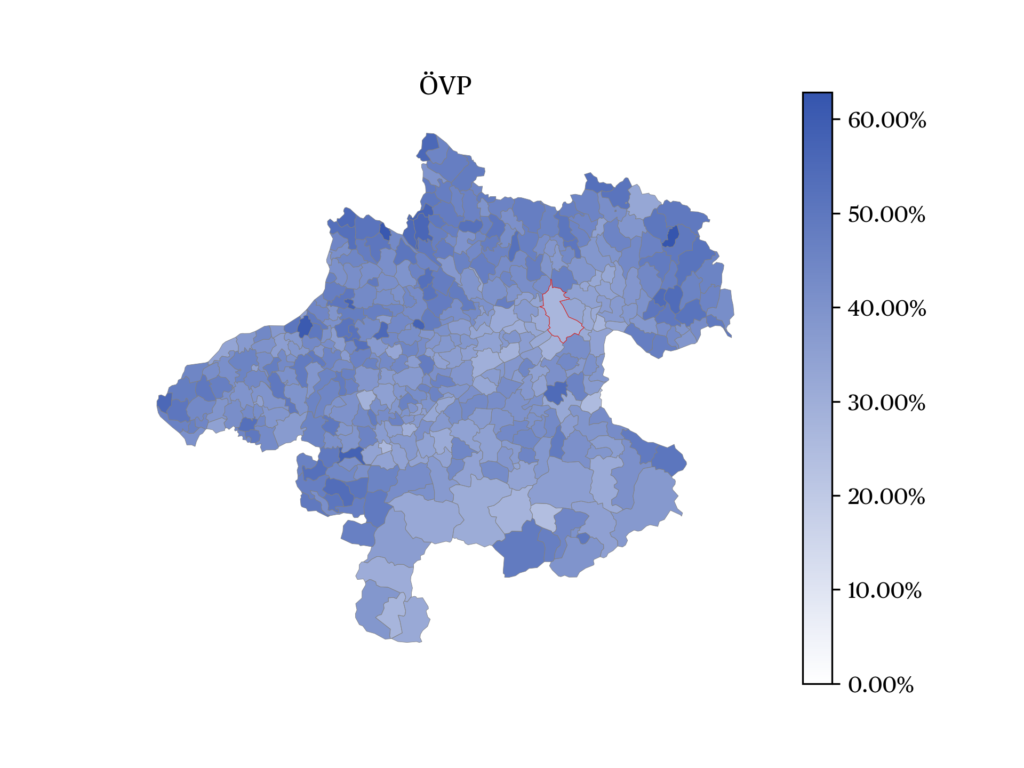
a • Score of the ÖVP at municipal level (ordinate) as a function of population density (abscissa) 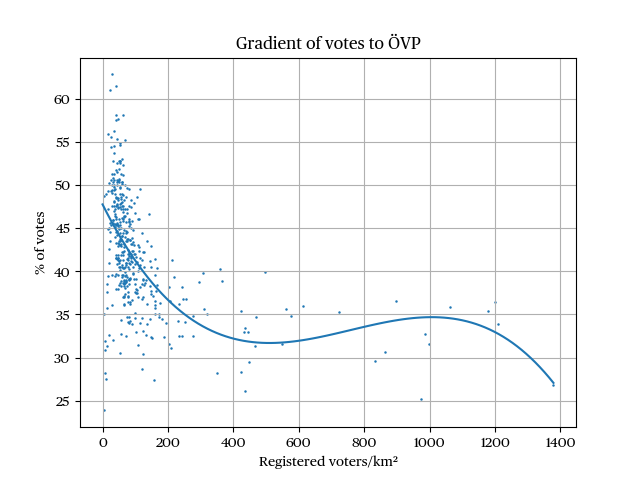
b • Score of the ÖVP at municipal level
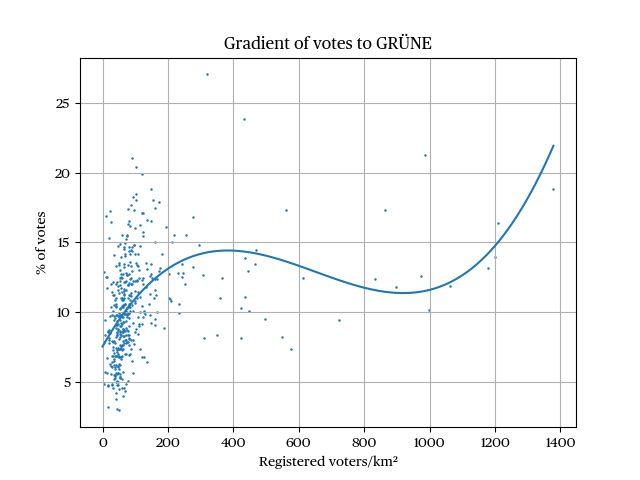
c • Score of the Greens at municipal level (ordinate) as a function of population density (abscissa) 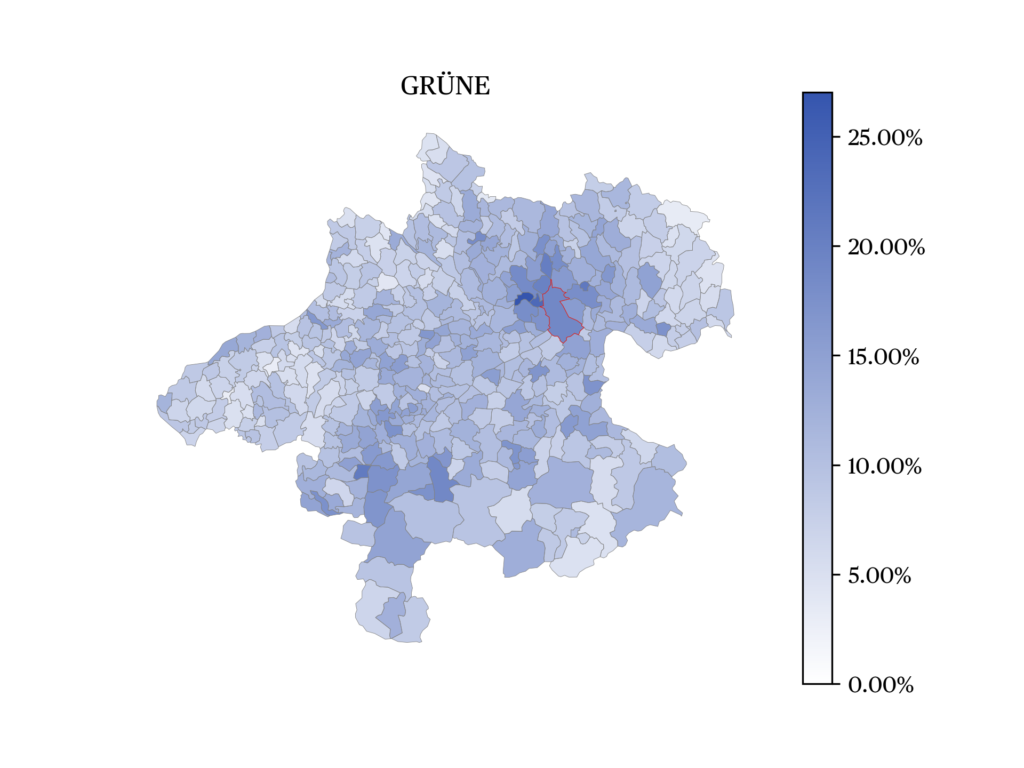
d • Score of the Greens at municipal level
Geographical trends in voting behaviour
If one analyses the election results of the parties according to geographical criteria, some characteristic patterns emerge (Eberl et al. 2020 : 1358): the victorious ÖVP again tended to do better in rural municipalities than in urban areas (Figure a). The ÖVP achieved its best results in rural regions in the north and south-west of Upper Austria and received lower voter support in the state capital Linz and in the south (Figure b). The FPÖ, on the other hand, had its voter strongholds in rural municipalities in the west near the Bavarian border. A principal component analysis shows that 26% of the deviations from the average result of the state election can be attributed to the better performance of the FPÖ in the west and the comparatively weaker performance of the other parties in this part of the state (Figure e, on the right). Unlike the ÖVP and the FPÖ, the Greens (and also the NEOS) registered a higher voter popularity in urban areas than in rural areas (Figure c). A closer look at the municipal results shows that the Greens had strongholds not only in urban areas (especially in Linz and its environs), but also in individual rural municipalities in the north and south (Figure d). The votes for the SPÖ were concentrated — as in the 2015 state election — mainly in Linz and its surroundings as well as in individual municipalities in the south. The good performance of the SPÖ (and the Greens) in these areas corresponds with comparatively weaker results for the other parties (Figure e, on the left). In the south and in the industrially structured central area, the SPÖ has core voters from the traditional, unionised working-class milieus, but — as in 2015 — was not able to mobilise more strongly away from these traditional SPÖ power centres. The MFG appealed to voters in different parts of the country and was strongest in those municipalities where the Covid-19 vaccination rate of the population is low, i.e. below the Upper Austrian national average (ORF 2021g).
Government formation
During the election campaign, the ÖVP avoided concrete statements on coalitions and left all options open. A possible government with the FPÖ was made conditional on the state FPÖ consistently distancing itself from the right-wing populist line of its federal party (Die Presse 2021). The FPÖ openly campaigned for a continuation of the coalition with the ÖVP, and the Greens also expressed interest in a government with the ÖVP. The SPÖ, on the other hand, did not comment on a possible government participation. Upper Austrian voters did not show a clear preference for a particular government coalition, and ÖVP voters were also split on the coalition question.
4
Due to the election results, four parties (ÖVP, FPÖ, SPÖ, Greens) are represented in the next state government, while NEOS and MFG, despite their successful entry into the state parliament, did not have enough for a government seat. In accordance with political practice, party talks on a future coalition government began after the official final results of the state elections were available.
As a decisive player in the party system, the Upper Austrian ÖVP had several options for forming coalitions (Müller 2006 : 362). In view of the results of the state elections, coalition governments of the ÖVP with the FPÖ, the SPÖ or the Greens were possible, each of which had different-sized majorities in the state parliament. Two combinations seemed unlikely from the outset. The Greens and the ÖVP have such different ideological positions on important issues such as climate protection, transport, asylum and security policy that a long-term government cooperation would be fraught with conflict. Although an ÖVP-SPÖ coalition was supported in principle by the regional Chamber of Commerce and Labour, the SPÖ did not see itself in the role of junior partner (“majority procurer”) of a strong ÖVP.
After brief and non-binding exploratory talks with all parties represented in the state parliament, the party executive of the ÖVP unanimously decided shortly after the state election to start coalition negotiations with the FPÖ, which were finalised after 26 days so that the division of portfolios and the government programme could be presented. (ORF 2021h). The ÖVP-FPÖ government means the prolongation of a functioning partnership and, with 33 of 56 mandates, has a broad majority in the state parliament. On important issues such as asylum, integration, economic and location policy, the ideological distance between the two parties is small, so that compromises between the coalition partners are easier to realise. Another argument in favour of the ÖVP-FPÖ coalition was that the parliamentary election campaign between these two parties was conducted relatively fairly over long stretches. In the future joint government, the power imbalance between the ÖVP as the election winner and the FPÖ as the election loser is more pronounced, which from the ÖVP’s point of view spoke in favour of a new edition of this coalition variant. From the perspective of coalition theory (Buzogány & Kropp 2013 : 261-266), the ÖVP-FPÖ government is a minimum-win coalition, characterised by a pronounced asymmetry of power and little ideological distance between the parties involved.
Consequences of the state election
The Landtag election result has no consequences for the next National Council election, as the legislative period will not end until 2024. More important is the effect on the balance of power in the Bundesrat, the second chamber of the Austrian parliament delegated by the Länder. The composition of the Bundesrat depends on the results of the state elections. The losses of the FPÖ in Upper Austria mean that one mandate in the Federal Council changes from the FPÖ to the ÖVP. As a result, the opposition, which consists of the FPÖ, SPÖ and NEOS in the federal government, loses its Bundesrat majority of 31 MPs. It can therefore no longer veto legislation passed by the governing parties, the ÖVP and the Greens, in the National Council. This veto delays the legislative process by a maximum of eight weeks and in the past contributed to a better integration of the opposition parties in parliamentary work. Thus, the election result in Upper Austria also implies a sensitive loss of power for the opposition at the federal level.
Despite their regional character, state elections are also a test of mood for the incumbent federal government and a seismograph for the overall “political atmosphere” in a country (Schakel & Romanova 2018, Schakel & Jeffery 2013). The Upper Austrian election result certainly did not mean a political tailwind for the federal government of the ÖVP and the Greens. The unexpectedly high gains of the MFG are an expression of the dissatisfaction of parts of the electorate with the Covid-19 measures at federal and state level. To a certain extent, the Upper Austrian state election can thus be interpreted as a – moderate – protest election against the federal and state governments. Against this background, it cannot be ruled out that the outcome of the state election will have an impact on future Covid-19 measures and influence the handling of the sensitive issue of Covid vaccination. The MFG’s performance also reflects the loss of trust in politics and its ability to solve complex problems, which has been growing for years (OGM 2021). It would be interesting to observe whether MFG remains an Upper Austrian phenomenon or whether it also runs successfully in local and state elections in other states. The question of the MFG’s longer-term political prospects after the end of the Covid 19 pandemic remains of interest.
Literature
Buzogány, A. & Kropp, S. (2013). Koalitionen von Parteien. In Niedermayer, O. (éd.), Handbuch Parteienforschung, Wiesbaden, pp. 261-294.
Dachs, H. (2006). Parteiensysteme in den Bundesländern. In Dachs, H. et al. (eds.), Politik in Österreich. Das Handbuch, Wien, pp. 1008-1023.
Die Presse (2021). Oberösterreich: Stelzer schließt Pakt mit «Kickl-FPÖ» aus. Die Presse. Online.
Eberl, J.-M., Huber, L.-M. & Plescia, C. (2020). A tale of the firsts: the 2019 Austrian snap election. West European Politics 34:6, pp. 1350-1363.
Fallend, F. (2019). Vom Finanzskandal zur „Normalisierung“. Eine Analyse der Salzburger Landtagswahlen 2013 und 2018. In Heinisch, R. et al. (eds.), Salzburger Jahrbuch für Politik 2018, Wien, pp. 9-48.
Kleine Zeitung (2021, 13 September). Kleine Zeitung: Oberösterreich. Umfrage sieht Impfgegner-Partei im Landtag. Online.
Kritzinger, S. et al. (eds.) (2014). Die Nationalratswahl 2013. Wie Parteien, Medien und Wählerschaft zusammenwirken, Wien/Köln.
Liegl, B. (2006). Kleinparteien. In Dachs, H. et al. (eds.), Politik in Österreich. Das Handbuch, Wien, pp. 402-411.
Müller, W. C. (2006). Die Österreichische Volkspartei. In Dachs, H. et al. (eds.), Politik in Österreich. Das Handbuch, Wien, pp. 341-362.
Nachrichten (2021, 9 July). Drei Monate vor der Wahl: ÖVP bleibt Erster, FPÖ legt zu. Oberösterreichische Nachrichten. Online.
OGM (2021). Vertrauensindex Institutionen Juli 2021. OGM/APA. Online.
OÖ (2021). Landtagswahl 2021: Wählerstromanalyse. Abteilung Statistik Land Oberösterreich. Online.
ORF (2021, 1 September). Warum sich Menschen nicht impfen lassen. ORF. Online.
ORF (2021b, 15 September). Radiofragestunde mit Birgit Gerstorfer, SPÖ. ORF. Online.
ORF (2021c, 16 September). Radiofragestunde mit Manfred Haimbuchner, FPÖ. ORF. Online.
ORF (2021d, 9 September). Wahlkampfauftakt von NEOS in Linz. ORF. Online.
ORF (2021e, 11 September). Radiofragestunde mit Felix Eypltauer, NEOS. ORF. Online.
ORF (2021f, 27 September). Landtagswahl Oberösterreich 2021. ORF/ISA/SORA. Online.
ORF (2021g, 27 September). Wo die MFG punkten konnte. ORF. Online.
ORF (2021h, 4 October). ÖVP führt Koalitionsverhandlungen mit FPÖ. ORF. Online.
Profil (2021, 28 September). Meinungsforscher Peter Hajek über die Wahlmotive bei der Oberösterreich-Wahl. Profil. Online.
Research Affairs (2021). Umgang der Politik mit dem Coronavirus in Österreich. Online.
Schakel, A. H., Romanova, V. (2018). Towards a scholarship on regional elections. Regional & Federal Studies, 28:3, pp. 233-252.
Schakel, A. H., Jeffery, C. (2013). Are Regional Elections really “Second-Order” Elections? Regional Studies 47:3, pp. 323-341.
Wiener Zeitung (2021, 19 August). Auch Oberösterreich Wahl Corona-infiziert. Wiener Zeitung. Online.
Notes
- Official data of the state of Upper-Austria, 26 September 2021.
- Oberösterreichische Landesverfassung, art. 17(2), Oberösterreichische Landeswahlordnung, § 65.
- Oberösterreichische Landesverfassung, art. 43(2).
- According to a poll conducted by GMK Meinungsforschung in early September (n=500, variation +/- 5 %), about 35 % preferred an ÖVP-FPÖ coalition, 23 % a government of ÖVP and Greens and 16 % a grand coalition. About the same number of ÖVP voters prefer a government with the FPÖ or with the Greens.
citer l'article
Harald Stöger, Regional election in Upper Austria, 26 September 2021, Mar 2022, 129-135.
à lire dans cette issue
voir toute la revue







